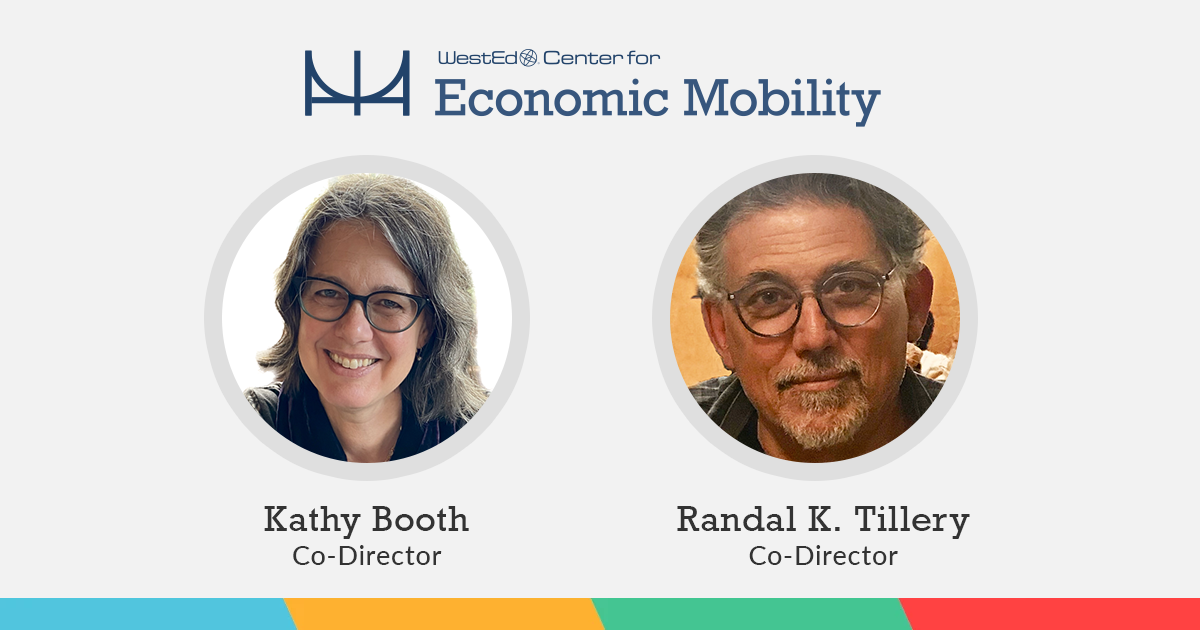Building an Economic Mobility Movement
Posted on by Kathy Booth, Randal Tillery

This post was originally published by WestEd’s Center for Economic Mobility.
By Randal K. Tillery and Kathy Booth, Co-Directors of the Center for Economic Mobility
A year ago, WestEd launched the Center for Economic Mobility. We were in good company. A number of organizations that focus on education, workforce development, and public policy have been sharpening their focus on whether people are able to attain living-wage jobs, with the social, health, and community benefits that become possible with financial security. This shared awareness is an opportunity to strengthen economic mobility pathways.
In this blog post, we reflect on the work the Center has done with our partners over the past year to ensure better economic outcomes for all learners.
Identifying Drivers of Economic Mobility
While education is a powerful social elevator, many factors constrain who accesses and benefits from learning opportunities. The Center is partnering with others to explore the drivers of economic mobility and to identify structures that create gaps in opportunity and reinforce income inequality. Our goal is to generate new information that can move national conversations from anecdote to evidence. For example, leveraging data generated through a partnership with the California Community Colleges Chancellor’s Office, we demonstrated the low rate of transition from adult education to community college and then briefed national policymakers to clarify strategies for stronger outcomes. Working with the University of Michigan, we documented the earnings implications of taking a few career-related courses and then led statewide planning sessions in Ohio and Colorado to inform efforts to support adult learners.
Bridging Policy and Practice
Sustainable change requires working from both the bottom and the top, so that the vision of policymakers is informed by those closer to the ground, and the daily work of practitioners advances far-reaching aspirations. Recently, in an effort to make access to education more affordable, California passed legislation that incentivized all students to complete financial aid applications. Given that few high schools have the staff or the expertise to help students navigate these complex forms, the Center partnered with the state, advocates, and educators to post resources and self-directed learning opportunities that will help counselors and administrators meet this ambitious goal. We are now leveraging this same framework to develop a knowledge-sharing website for the state of Nevada that will support K–12 institutions to improve their college and career readiness outcomes.
Operationalizing Systems Change
Given the fractured and short-term nature of funding in education and workforce development, innovation is often focused on pilot projects, while most learners must continue to navigate the status quo. Therefore, we are working with the National Science Foundation to address the structures that prevent historically marginalized populations from pursuing the STEM pathways that are more likely to provide living-wage jobs. By helping the National Science Foundation grantees quantify the facets of systems change and focus on shared measures of progress, we are building bridges between disparate efforts and identifying ways to insulate structural change during periods of funding instability. We are also applying this approach to support the scaling of programs that focus on college-going rates for underrepresented students.
Changing the Conversation
As skepticism grows about the value of a college education, despite overwhelming evidence that this is the best avenue to a living wage, it is imperative that we clarify how education supports—and debt impedes—economic mobility. Therefore, the Center is partnering with experts like the Georgetown Center for Education and the Workforce and the Centers of Excellence for Labor Market Information to clarify the importance of attending to prevailing wages and the skills of learners when aligning educational opportunities to employment demand. In addition, we are working with the National Association of Systems Heads to engage educators on new metrics for postsecondary attainment, debt, and social mobility. These new metrics clarify how educators can redesign higher education so that low-income students can attain greater economic stability and opportunity.
Join Us!
As the Center enters our 2nd year, we are focused on expanding our work with others. You can access and share the free resources we have posted on our website or reach out to us to explore new ideas. Together, we can grow an enduring movement for economic mobility that is centered on learners, focused on the root causes of inequity, and advancing institutional change.
